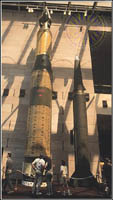| |
||||||||||||||||||||||||||||||||||||||||||||||
The Pershing-II and SS-20 missiles exhibited here are two of more than 2,600 nuclear missiles banned by the Intermediate-range Nuclear Forces (INF) Treaty, which was signed by the United States and the Soviet Union in December 1987. The INF Treaty is a milestone in the effort to control nuclear arms. It is the first international agreement to eliminate an entire class of nuclear weapons--those having a range of 500-5,500 kilometers (300-3,400 miles). The U.S. Pershing-II and the Soviet SS-20 were regarded as the most threatening missiles in this class.
Missiles and related equipment banned by the INF Treaty were eliminated at designated facilities in the United States, Europe, and the Soviet Union. Elimination was accomplished by explosive or physical demolition, static firing, launching to destruction, or rendering inoperable for the purpose of museum display. Inspectors from the U.S. On-Site Inspection Agency monitored the elimination of Soviet missiles. Elimination of U.S. missiles was monitored on-site by inspectors from the Soviet Nuclear Risk Reduction Center. The nuclear warheads, fuel, guidance systems, and electronics were removed from the missiles and allowed to be used in weapons not limited by the INF Treaty. Eliminations began in August 1988 and were completed by June 1991. PERSHING-IIA mobile intermediate-range ballistic missile
of the U.S. Army, the Pershing-II was deployed at American bases
in West Germany beginning in 1983 and aimed at targets in the western
Soviet Union. It carried a single thermonuclear warhead with an
explosive force equivalent to 5-50 kilotons (5,000©;50,000 tons)
of TNT. The terms of the INF Treaty required that all Pershing-IIs
and their support equipment be eliminated. The missile displayed
here is a training version, but its dimensions and weight are identical
to those of an operational Pershing-II.
SS-20 "SABER" The SS-20 was a mobile intermediate-range
ballistic missile of the U.S.S.R. Strategic Rocket Forces. It carried
three independently targeted thermonuclear warheads, each with an
explosive force equivalent to 250 kilotons (250,000 tons) of TNT.
Beginning in 1976, the SS©;20 was deployed at 48 bases in the
Soviet Union, putting it within range of targets in western Europe
and Asia. The terms of the INF Treaty required that all SS-20s and
their support equipment be eliminated. The missile shown here is
a training version, but its dimensions are identical to those of
an operational SS-20.
More Information: |
![]() 1983
Pioneer | Milestones of Flight | 1999
Breitling Orbiter 3 Gondola
1983
Pioneer | Milestones of Flight | 1999
Breitling Orbiter 3 Gondola ![]()
©National Air and Space Museum
